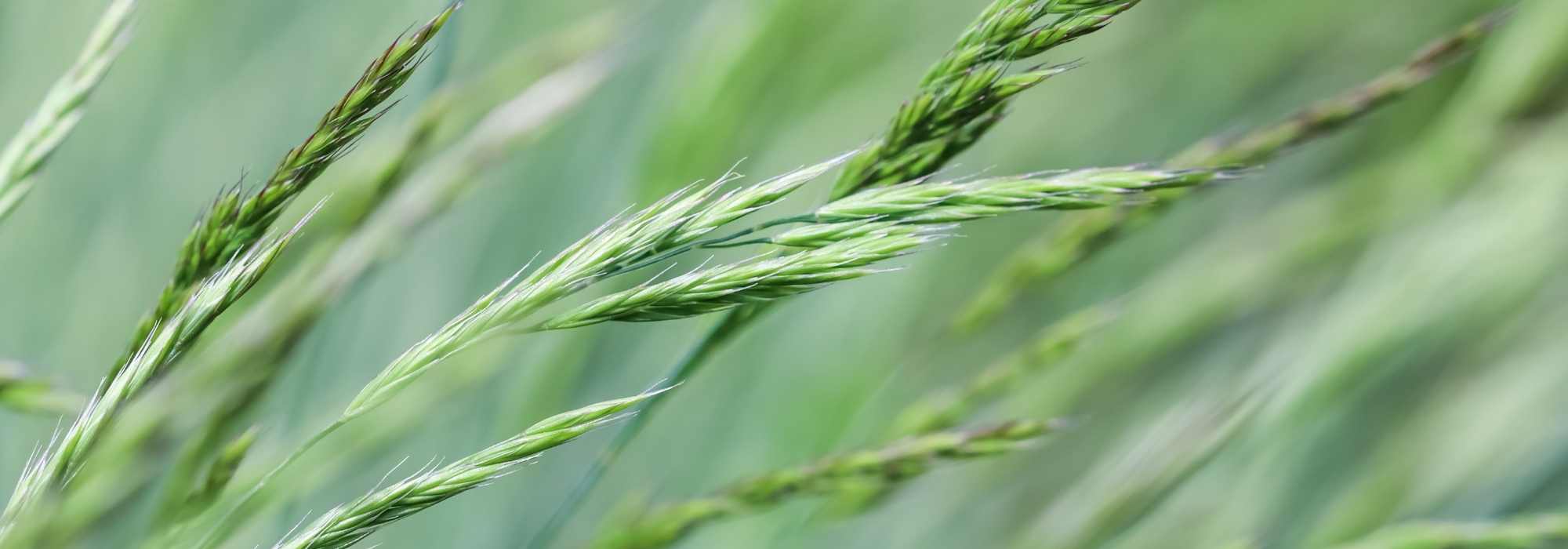
Which grasses to choose for an acid soil?
Our selection of 10 species that adapt to a pH below 7
Contents
Elegant and resilient, ornamental grasses form a vast family of monocotyledonous plants, characterised by narrow foliage and inflorescences in spikes or panicles. They undeniably bring movement and lightness to flower beds, borders, and rockeries in gardens. However, grasses are not immediately associated with acidic soils, which are often linked to wooded and damp areas, heaths, and forests. Think again! Some species of grasses, particularly versatile, have developed specific adaptations that allow them to thrive in acidic soils to create original and sustainable spaces.
Discover our selection of grasses that will become fantastic allies in gardens with acidic soil, along with all our maintenance tips and the most successful plant associations.
What characterizes an acidic soil? What are its advantages?
A soil is considered acidic when its pH is below 7, often between 5 and 6 for the most common soils. This acidity is mainly due to natural factors, such as the decomposition of organic matter, leaching of minerals, the presence of a parent rock like granite, or the addition of certain chemical fertilisers. Gardeners tend to have a low opinion of this type of soil, as the activity of micro-organisms is relatively reduced. Likewise, deficiencies are common.
However, an acidic soil is not always a bad soil. Thus, humifère soils, rich in humus, are generally acidic soils. Moreover, an acidic soil benefits from natural drainage due to its lightness. It can also be well supplied with certain micronutrients, such as iron.
So, make the best of a bad situation. Admittedly, your soil is acidic, but it can be an asset if you choose plants that thrive naturally in it. And some grasses particularly enjoy it.
Ten beautiful grasses suitable for cultivation in acid soil
Grasses are herbaceous plants that adapt equally well to both nutrient-rich and nutrient-poor soils. This is why, some of them, often thriving naturally in heathland and wooded areas, will particularly enjoy an acidic soil. We have selected the ten most interesting grasses for you.
Japanese grass (Hakonechloa macra)
In its natural habitat, Japanese grass (Hakonechloa macra) thrives at the edge of woodlands, on semi-shaded slopes with cool, humus-bearing soil. This is why it adapts quite well to acidic soil. Over time, it forms beautiful clumps of lanceolate and lush foliage that cascade in overlapping layers. Hakonechloa macra also produces flowering thin spikes that last throughout the winter. Rich in numerous cultivars, Japanese grass offers a wide range of colourful foliage, from green to golden yellow (‘All Gold’), to orange and bronze yellow (‘Nicolas’), from mahogany red (‘Naomi’) to burgundy red (‘Mulled Wine’) at the end of the season.
Japanese grass thrives equally well in shade, partial shade, or full sun (if the soil is sufficiently cool).
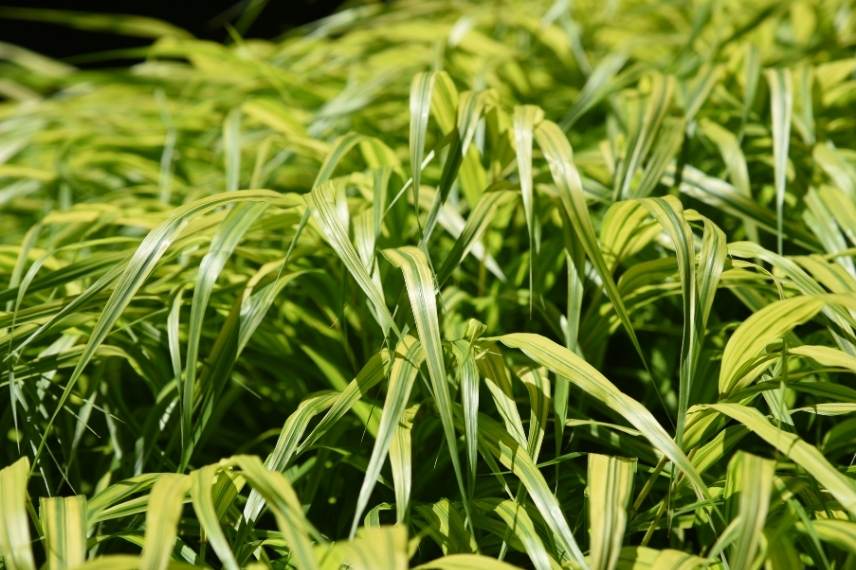 Japanese grass
Japanese grass
Blue molinia (Molinia caerulea)
The blue molinia(Molinia caerulea) is a native grass, originating from acidic heathland and wind-swept areas. It certainly has its place in acidic soil. This grass forms beautiful dense clumps of foliage, relatively discreet in summer. In autumn, its foliage takes on magnificent golden yellow to orange hues. The tallest varieties like ‘Fontäne’ or ‘Skyracer’ are impressive, while the more compact varieties benefit from being planted in masses.
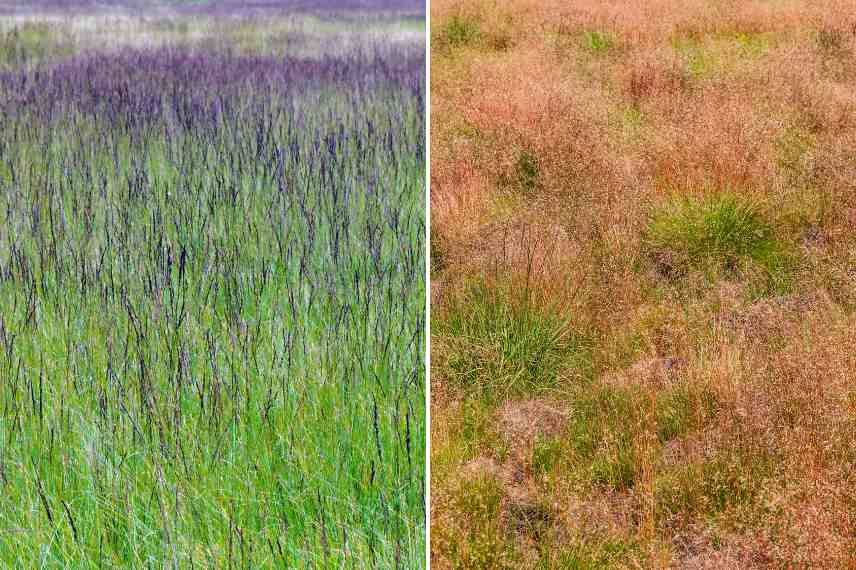 Blue molinia through the seasons
Blue molinia through the seasons
Common reed (Phragmites australis)
The common reed(Phragmites australis) is a large grass with thick, rigid stems and leaves. These vertical culms, equipped with leaves, can be variegated with gold (‘Variegatus’) for added ornamentation. The common reed produces purple inflorescences in August, which turn silver in autumn. The common reed enjoys having its feet in water. Due to its invasive nature, it should be avoided in small spaces.
Purple sugar cane (Saccharum officinarum violaceum)
The purple sugar cane (Saccharum officinarum violaceum) is a large grass that can reach 2.5 m in height and 2 m in width. Reserved for regions with a mild climate (it is frost-sensitive below -5 °C), this grass offers beautiful ribbon-like, narrow, and arching foliage, supported by enormous stems. This deciduous foliage emerges dark purple before turning dark green, tinged with purple and red.
Wood rush (Luzula sylvatica)
The wood rush (Luzula sylvatica) is a grass from the family of rushes (Juncaceae). It forms a clump that is wider than it is tall, consisting of rigid, glabrous, smooth, and shiny leaves, resembling plastic, with non-cutting edges. It produces loose and inconspicuous spikes between June and August, which have ornamental interest, especially when planted in masses. Varieties with golden foliage (‘Solar Flare’) or variegated (‘Marginata’) bring light to shady areas. It is an ideal grass for ground cover or edging.
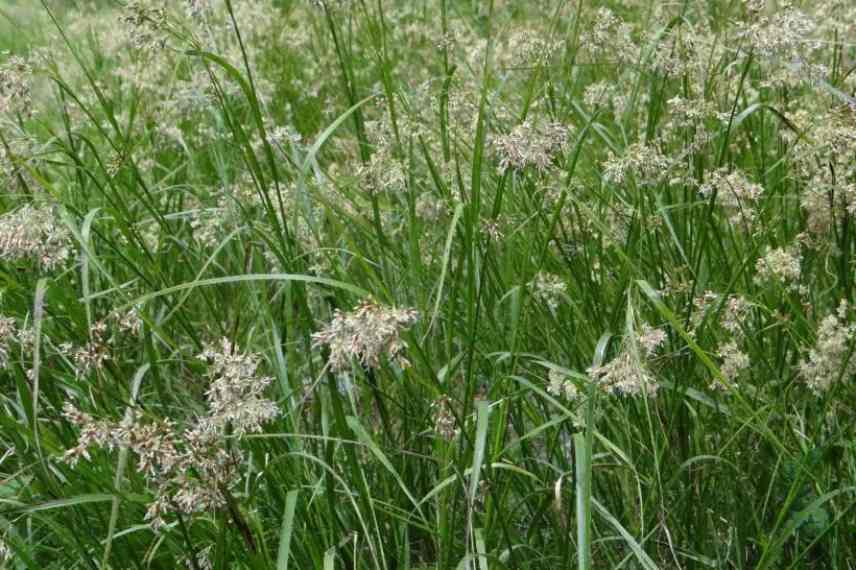 Wood rush
Wood rush
Rushes (Juncus)
The rushes (Juncus) are herbaceous plants that thrive in humid, even aquatic environments. They are often planted along waterways or ponds where they spread via their rhizomes. Rushes form clumps of tall, leafless, very straight, and flexible stems. Some varieties like the spiralled rush (Juncus effusus ‘Spiralis’) are very original with their twisted stems. Rushes flower in brownish spikes.
Flexible canche (Deschampsia flexuosa)
The flexible canche (Deschampsia flexuosa) forms a dense and low clump of evergreen, very fine green leaves. From June to August, the foliage literally disappears under a profusion of fine stems, topped with very light, beige-golden inflorescences tinged with bronze, creating a misty effect. This grass self-seeds very easily and thrives in all exposures. It is a “wise” grass that gives an impression of wild meadow.
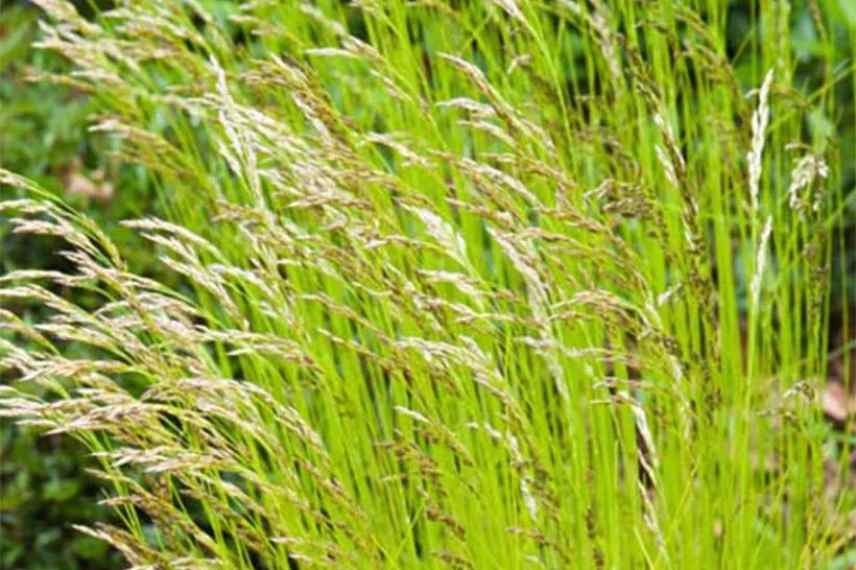 Flexible canche
Flexible canche
Wood sedge (Carex sylvatica) and pendulous sedge (Carex pendula)
The wood sedge (Carex sylvatica) and the pendulous sedge(Carex pendula) are two graceful and vigorous grasses, perfectly suited to acidic soils. The wood sedge forms a tuft of linear leaves that are bright green. The pendulous sedge takes the form of a large clump of broad, arching evergreen leaves. They offer fine and tall stems of great elegance, consisting of a terminal spike of male flowers and two to three female spikes.
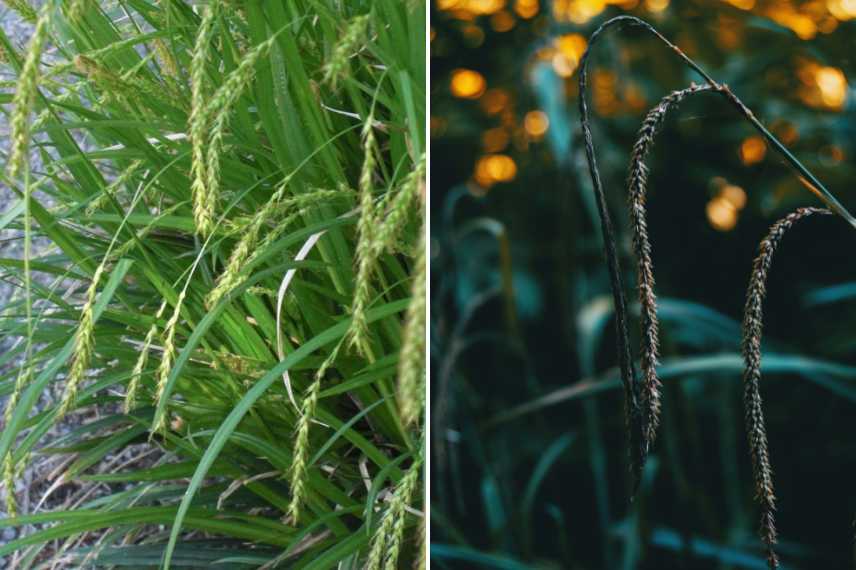 Wood sedge and pendulous sedge
Wood sedge and pendulous sedge
Sheep fescue (Festuca ovina)
The sheep fescue (Festuca ovina) is a compact and upright grass, very resilient. It forms a small tuft of fine, bluish-green foliage that turns straw yellow in winter. Its inflorescences bloom in green spikes that turn purplish. It adapts to all types of soils, including acidic ones, and can be planted at the edge, in rockeries, or in borders.
How to plant and care for these acid soil grasses?
After choosing the most suitable grasses for acidic soils, it’s time for planting. Although they are not very demanding, these grasses will be more vigorous in well-prepared soil. Moreover, their establishment will be greatly facilitated.
In acidic soil, adding compost or organic matter helps to balance the pH and enrich the soil with nutrients. It is also essential to remove weeds that may compete with the young grasses. Finally, a bit of sand or gravel should be added to the bottom of the hole to improve drainage. Once your grasses have been planted and generously watered, it is important to add an organic mulch such as wood chips, fallen leaves, or pine needles to retain soil moisture and limit the growth of adventive plants.
In terms of maintenance, grasses are hardly more demanding than during planting. They will need to be watered regularly in the weeks following planting, and during periods of intense heat or drought. It is also necessary to remove dead stems at the end of winter to encourage new growth in spring.
How to combine grasses in acidic soil?
Combining grasses with other plants suited to acid soils creates harmonious scenes, rich in textures, colours, and shapes. However, for perfect success, it is essential to choose acidophilous plants or at least those tolerant of acid soils. Among the perennials, one can mention astilbes, tiarellas and heucherellas, or even hostas to provide interesting contrasts.
On the shrub side, heathers always form successful associations with grasses. These grasses can also be planted alongside rhododendrons and azaleas, as well as with Hydrangea macrophylla.
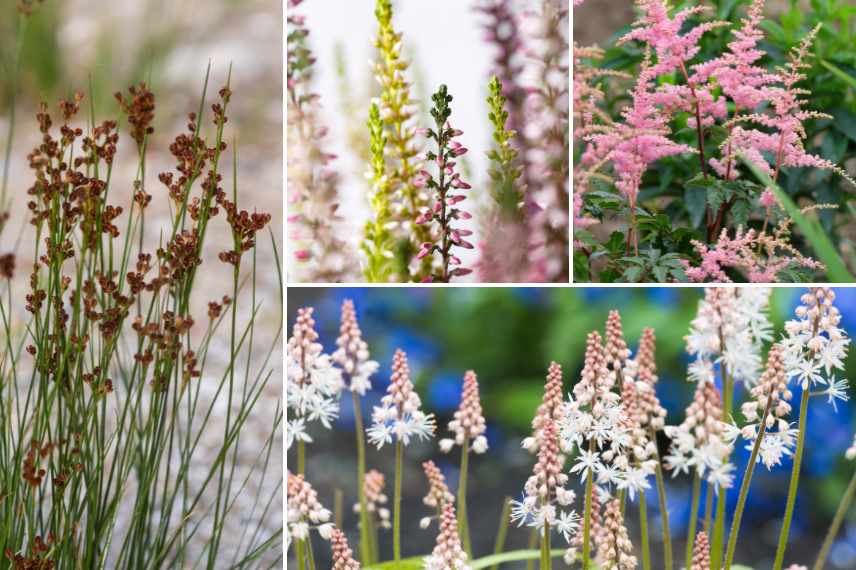
In acid soil, one can combine rushes with heathers, astilbes, and tiarellas
Ferns of the genus Dryopteris or Athyrium and the creeping wintergreen (Gaultheria procumbens) pair very well with wood rush due to their ground-covering aspect. Finally, in spring, the bulbs of daffodils, crocuses, and camassias bring a lovely touch of colour before the grasses resume growth.
- Subscribe!
- Contents
































Comments